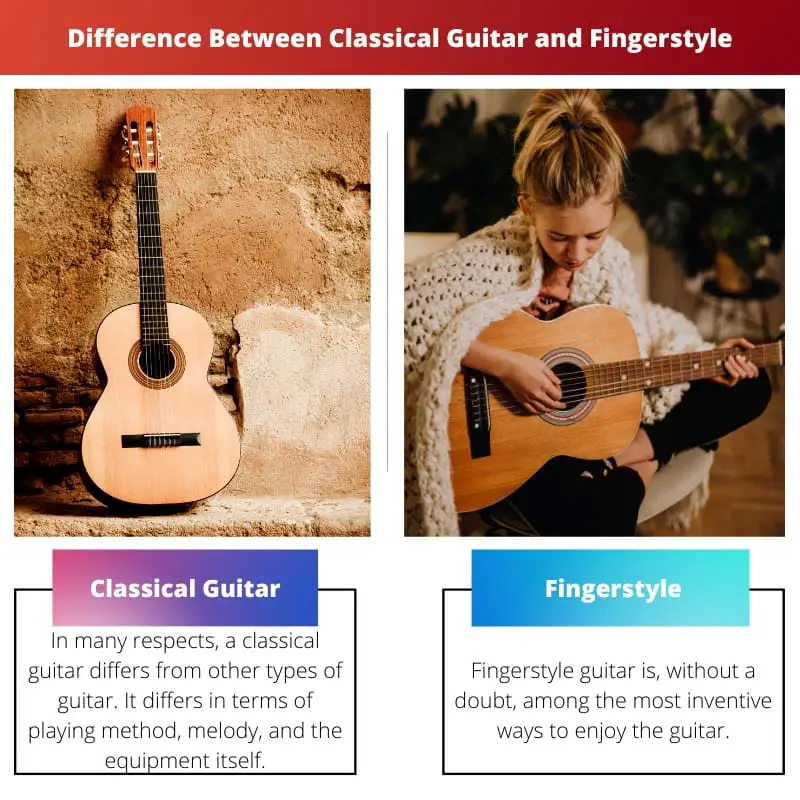It is said that music can come in any form and language. But instruments play a major role in creating a melody.
When talking about the instruments, how can one forget about guitars? Guitars, in general, come in many forms and are played in varied styles, classical and Fingerstyling being some of them.
Key Takeaways
- Classical guitar is a music genre and playing technique using a nylon-stringed guitar, while fingerstyle is a general term for plucking the strings directly with the fingertips or nails.
- Classical guitar music follows strict rules and conventions, while fingerstyle techniques can be applied to various music genres, including folk, jazz, and pop.
- Classical guitarists use a specific sitting position and hand posture, while fingerstyle guitarists may adopt a more casual approach depending on the genre.
Classical Guitar vs Fingerstyle
The classical guitar is the method of playing the guitar, coupled with a specific repertoire of pieces used in classical music and other styles. Fingerstyle is the technique of playing the guitar by plucking the strings with our fingers or picks attached to fingers, instead of flatpicking.

In many respects, a classical guitar differs from other types of guitar. It differs in terms of playing method, melody, and the equipment itself. A classical player is any guitarist who performs on conventional guitars.
Starting with some of its characteristics as an entity, today’s market offers a wide range of guitars. Fingerstyle guitar, also known as fingerpicking guitar, is an acoustic approach wherein the strings are played using the fingernails of the right hand.
Fingerstyle guitar is, without a doubt, among the most inventive ways to enjoy the guitar. Users should be capable of playing chords, melodies, percussion guitar, and distinctive rhythms once they’ve mastered this approach.
Comparison Table
| Parameters of Comparison | Classical Guitar | Fingerstyle |
|---|---|---|
| Definition | Classical guitar is a technique for playing the instrument that is accompanied with a repertory of pieces written specifically for it. | The phrase “fingerstyle” refers to using one’s fingertips instead of a barre chord to play the instruments. There’s a whole variety of styles, vary from simple folk-style “Travis picking” to more intricate compositions. |
| Main Components and Approach | Classical guitar approach has a very rigorous structure in terms among which fingernails puck which string, but several stylists, especially those who play fusing, alter and push the rules. | The main component of this technique is an alternate thumb bass rhythm, in which the thumbs knock two or even more base strings in sequence. |
| Primarily Focused on | While other types may focus on other aspects of the instrument, classical guitarists devote a significant amount of time to studying the “how” of playing, like how to place the it’s body. | The steel-string acoustic guitar is the instrument of choice for most self-identified fingerstyle performers. There are a few guitarists who perform fingerstyle on electric guitar, but they are few and far between. |
| Instructed Under | Classical guitarists frequently study with instructors who, in return, trained with teachers due to the obvious emphasis on techniques as well as compositional comprehension. | Fingerstyle is self-taught. What constitutes “excellent technique” is a subject of debate. |
| Composed as | Composed melody in standardized music theory is most used when playing classical guitar. | The majority of well-known fingerstyle musicians mix their own creations with interpretations of popular pieces. |
What is Classical Guitar?
The classical guitar is a type of instrument used throughout classical and many other types of music. It is a forerunner of the contemporary acoustic and electric guitarists, which together employ metal strings.
It is an acoustical hardwood stringed musical instrument having chords composed of gut or nylon. Classical guitars are descended from the 15th and 16th-century Spanish vihuela as well as gittern.
Such guitars grew into the baroque guitar of the 17th and 18th centuries, then by the middle of the 19th century, early variants of the contemporary classical guitar.
The conventional classical guitar has 12 frets ahead of the frame for a right-arm dominant player and is appropriately supported up by the left thigh, such that the arm that pulls or riffs the strings always does locate at the rear of such soundhole.
A classical guitarist’s thumbs, index fingers, mid, as well, as rings play the strings. This is known colloquially as the “fingerstyle” approach.
It is important to note that somehow a classical guitarist isn’t using a picking.

What is Fingerstyle?
Fingerstyle is the practice of playing an instrument (Guitar) or bass guitar by strumming the threads straight with the tips, claws, or selections linked to fingertips.
The word “fingerstyle” is a bit of a misnomer as it may be found in a variety of musical genres and styles—but largely because it includes an entirely distinct method, not simply a “style” of performing, particularly for the guitarist’s going to pick aside.
Other than in classical guitar contexts, the phrase is considered synonymous with fingerpicking. However, fingerpicking too can apply to a particular heritage of folk, blues, and western musicality in the United States.
Because distinct digits produce sounds on the guitar instead of the hand operating as a separate entity (as when a musician holds a solo pick), a guitarist practicing fingerstyle might perform multiple musical components at the same time.
Several fingerstyle guitarists use a mix of acrylic nails as well as a thumb pick to boost tone while reducing nail wearing and the possibility of breakage or flaking.

Main Differences Between Classical Guitar and Fingerstyle
- Classical guitar is a style of playing the instrument that includes a repertoire of stuff written exclusively for it. Whereas the term “fingerstyle” relates to playing instruments with one’s fingertips rather than a barre guitar riff. There are many different styles, starting from basic folk-style “Travis picking” to a much more complex composition.
- In concerns of which fingernails strike which thread, the classical guitar technique has a very strict structure, although various artists, particularly those that play fusion, change and stretch the rules. The alternative thumb bass beat, wherein the thumbs strike two, or maybe more bottom strings in succession, is the primary aspect of this style.
- While some other sorts of guitarists may concentrate on various parts of the guitar, classical guitarists invest a good deal of time in learning the “how” of playing, such as how to position the body upon that instrument. As with most self-identified fingerstyle players, the steel-string acoustic guitar is the preferred tool.
- Due to the clear stress on technical and also compositional interpretation, classical guitarists study with educators who, in turn, studied with teachers. Whereas the most common finger style is the self-taught one. The definition of “great skill” is up for discussion now.
- When strumming classical guitar, one of the most common techniques is to use a prepared tune in established music theory. On the other hand, the bulk of well-known fingerstyle players combines their original compositions with covers of well-known songs.

- https://journals.sagepub.com/doi/abs/10.1177/000313139304300430?journalCode=staa
- https://arxiv.org/abs/2008.01431
